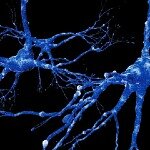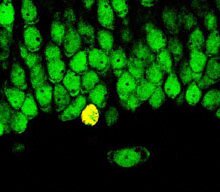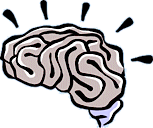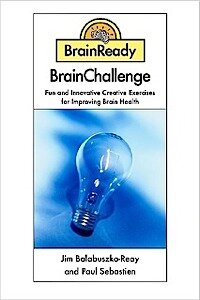
And these changes within the brain in response to new information, images, concepts, etc. can be quite sweeping, yet precise: consider the analogy of a film camera taking a picture of a flower. When the picture is taken, the film (your brain) is exposed to the new information of the image of a flower, and in order for this image to be retained, the film (your brain) reacts to the light information and changes -- to record the image of the flower. This new resulting image (or concept or other information or groups of information) is captured and stored by your brain via process of actual changes, which may not sound impressive until you really think about it: your physical brain is actually changing, molding, morphing, like plastic or putty, in response to information you receive! One can almost imagine the brain busily creating new areas and connections, re-routing existing connections, morphing and undulating in response to new information, like some amorphous alien creature, or perhaps "Chet" from the movie Weird Science...
Obscure 80's movie reference aside, let's talk about what the more practical (yet perhaps even more amazing) aspects of neuroplasticity and what it may mean for you, your friends and loved ones. First, consider that until recent years, it was largely believed that as we aged, our brain's neural networks became more and more fixed, making new learning and cognitive improvement efforts (such as brain exercises) difficult or even futile. But in just the two decades, an enormous amount of research has revealed that our brains NEVER stop adjusting or lose their plasticity, even into very old age, unlike general cognitive decline. Research in the mid-1990's (by Tortora & Grabowski) showed that indeed, there are at least two types of actual changes within our brains that occur with new learning:
1) A change in the internal structure of the neurons themselves, particularly in the area of synapses
2) An increase in the number of synapses between neurons.
Yes, this would also mean that a 55 year old woman learning new knowledge or skills or other information will experience new growth (synapses and neuron changes) and changes, just as a 25 year old man also will, just as a 80 year old woman will (with some differences between each person of course, based on combination of brain ability, mental condition, age, other factors).

Brain injury and plasticity: Perhaps most exciting and interesting is the area of injury-related neuroplasticity. Many of us have parents, friends or loved ones who have had a stroke, or other forms of brain injury -- and many of us have witnessed first-hand the incredible (often partial, sometimes full) recovery that can occur. From being barely able to speak a few words or remember simple things after the injury, to fully regaining speech and memory only a short time later, this is a wonderful example of our brain plasticity in action. During brain repair following injury, plastic changes are geared towards maximizing function in spite of the damaged brain. In studies involving rats in which one area of the brain was damaged, brain cells surrounding the damaged area underwent changes in their function and shape that allowed them to take on the functions of the damaged cells.
Although this phenomenon has not been widely studied in humans, data indicate that similar (though less effective) changes occur in human brains following injury, and perhaps more importantly, seeing such examples as stroke or head trauma victims recover over time illustrates the brain's amazing ability to re-route connections, change in response to damage and information and learning, and optimize itself for functional ability as quickly as it can.
What about brain exercises? Just as with the camera analogy and plasticity by induced by learning, brain exercises provide both "new learning" synaptic and neural growth (as most brain exercises involve some form of learning or adapting combinations of existing skills in new ways) yet also force previously unconnected, little-connected, or buried/past existing connections and abilities back into usage, strengthening those connections and abilities as well as forging entirely new ones (new inter-neural relationships between disparate areas). As proven by one's ability to, for example, learn a new type of math or logic puzzle or task and perform such skills across multiple variations, speed and accuracy of execution increases with usage (as many of you have told us about your ability to plow through the Sequence It or CodeBreaker or Simple Math exercises from our BrainFlex exercises).
As more research comes in regarding the effects of regular brain exercises on cognitive health, there are sure to be numerous examples of beneficial, exercise-induced neuroplasticity changes (akin to lifting weights at the gym and gaining new muscle mass and physiological changes over time) as well as overall benefits to neural health to keep those connections working well and quickly in the face of aging (akin to overall regular cardio, fitness, stretching and toning exercises keeping one's body lean, quick, healthy).
Putting neuroplasticity to work for you: this all sounds like neat research, but how can this help me? While we've only scratched the surface of the very deep, complex and fascinating area of neuroplasticity, the bottom line is that this exciting new field of research is just starting to illustrate how our brains are truly changeable. Malleable. Improvable, by things that you can do, actions that you can take to change your brain into the brain you would like to have.
By making new learning a priority activity in your everyday life, by regularly exercising your brain, by exposing your brain to the kinds of information, images, concepts, relationships that you would like the majority of your thoughts to be made up of, these are activities that can truly (and literally) change your brain for the better. And make it stronger, particularly if you can devote some time to new learning and experiences as well as exercising your brain and existing skills, keeping it strong in the face of age-related overall decline.
Don't let age serve as an excuse, either: as the research has shown, your brain's plasticity is largely intact and waiting, even into old age. So sorry, no saying "I'm too old to learn Japanese" or "I'm no good at even simple math equations anymore".
Your brain is waiting to be shaped and molded and changed, so get busy and make it better!




